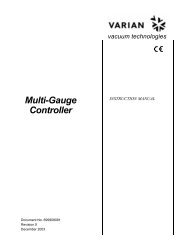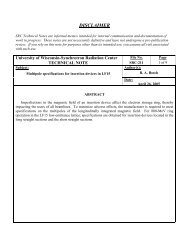SRC Users' Meeting - Synchrotron Radiation Center - University of ...
SRC Users' Meeting - Synchrotron Radiation Center - University of ...
SRC Users' Meeting - Synchrotron Radiation Center - University of ...
You also want an ePaper? Increase the reach of your titles
YUMPU automatically turns print PDFs into web optimized ePapers that Google loves.
TRIPLE PHOTOIONIZATION OF NEON AND ARGON NEAR<br />
THRESHOLD<br />
J.B. Bluett 1 , D. Luki 2 , S.B.Whitfield 3 , I.A. Sellin 4 , and R. Wehlitz 1<br />
1 <strong>SRC</strong>, UW-Madison, 3731 Schneider Dr., Stoughton, WI 53589<br />
2 Institute <strong>of</strong> Physics, 11001 Belgrade, Yugoslavia<br />
3 Department <strong>of</strong> Physics and Astronomy, UW-Eau Claire, WI 54702<br />
4 Department <strong>of</strong> Physics, <strong>University</strong> <strong>of</strong> Tennessee-Knoxville, TN 37996<br />
The threshold behavior <strong>of</strong> the triple photoionization cross-section <strong>of</strong> neon was<br />
investigated using monochromatized synchrotron radiation and ion time-<strong>of</strong>-flight (TOF)<br />
spectrometry. The monochromatized photon beam ionized neon or argon atoms in the<br />
experimental chamber. The ions created were accelerated by a pulsed electric field and<br />
detected by a Z-stack <strong>of</strong> microchannel plates [1].<br />
The absolute cross-section is<br />
found to follow the Wannier<br />
power law [2], i.e., the partial<br />
cross-section is proportional to<br />
the excess energy E raised to a<br />
power , E . We obtained<br />
an exponent <strong>of</strong> 2.20 0.05 that<br />
has a range <strong>of</strong> validity <strong>of</strong> ca. 5eV<br />
(green curve in Fig. 1). This<br />
result is consistent with the<br />
exponent <strong>of</strong> 2.162 predicted by<br />
theory and is also consistent with<br />
the finding <strong>of</strong> Samson and Angel<br />
[3].<br />
However, we did not find a secondary power law as in Ref. [3] but observed a smooth<br />
decrease <strong>of</strong> the exponent with increasing excess energy. Nevertheless, we could<br />
reproduce the exponent for the “second” power law as reported in [3] with an exponent <strong>of</strong><br />
1.89(4) (red curve) if we perfom the fit over the same energy range (5-9 eV) as in Ref [3].<br />
Also for argon, we can confirm the Wannier power law and determined an exponent <strong>of</strong><br />
2.21(12) in good agreement with the theoretical prediction. However, the range <strong>of</strong><br />
validity is significantly shorter than for Ne, namely ca. 2 eV only.<br />
This work was supported by NSF Grant No. 9987638. The <strong>SRC</strong> is operated under NSF<br />
Grant No. DMR-0084402.<br />
References:<br />
[1] R. Wehlitz, D. Luki, C. Koncz, and I.A. Sellin, Rev. Sci. Instrum. 73, 1671 (2002).<br />
[2] G.H. Wannier, Phy. Rev. 90, 817 (1953).<br />
[3] J.A.R. Samson and G.C. Angel, Phys. Rev. Lett. 61 1584 (1988).
















